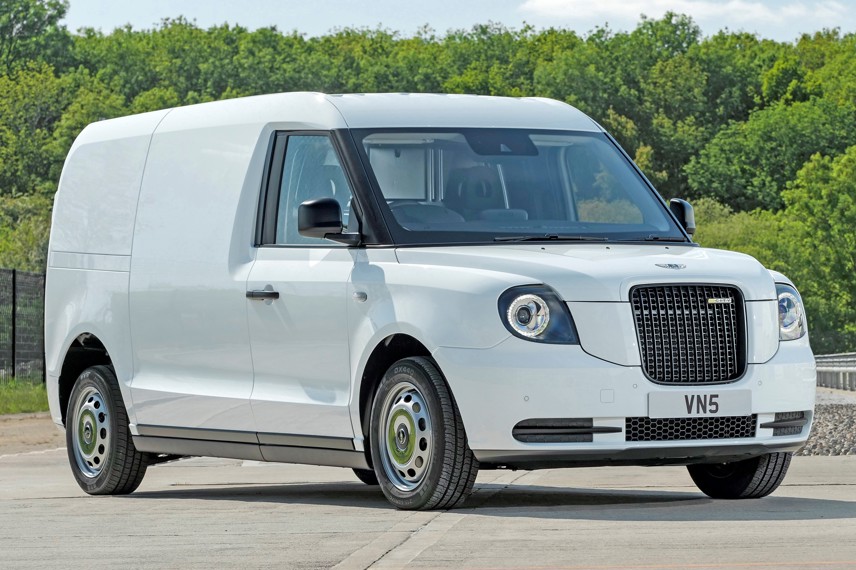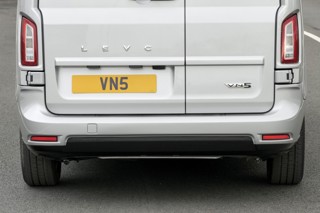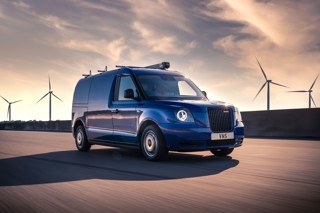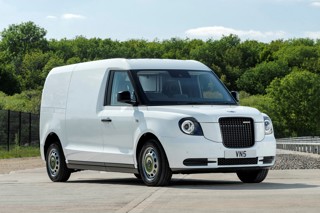Review
The first deliveries of the new British-built VN5 electric van from LEVC (London Electric Vehicle Company) are expected to arrive at fleet customers in early November.
Using the same eCity range-extender technology as the company’s TX taxi and the same front end, it has a range of 58 miles on zero-emission battery power, says head of product management James Drake-Lee. That increases to 301 miles when the vehicle’s 60kW 1.5-litre petrol-powered range-extending generator kicks in, he adds.
The figures are subject to WLTP certification.
Maximum gross payload is 830kg with a gross weight of 2.9 tonnes, and the newcomer comes with a 5.5cu m load area. “VN5 is 400mm longer than TX,” Drake-Lee says.
Using the range-extender approach rather than going the pure battery-electric route makes sense for many fleets because it matches their duty cycles more closely, he adds.
“The vast majority of the journeys vehicles operated by logistics companies make are not solely within cities,” Drake-Lee points out.
“Let’s suppose you have to drive from Heathrow Airport to central London to make four deliveries,” he continues. “That’s a round trip of 47 miles, much of it on the M4, with just 10 miles driven in the Ultra Low Emission Zone (ULEZ). VN5 can do that run six times a day. A battery-electric van of a similar size can’t because it doesn’t have the range.”
When VN5 enters the ULEZ it can switch to battery power only in line with zero-emission requirements, thereby avoiding the £12.50 daily levy. As a consequence, it gives fleets the best of both worlds, according to LEVC.
The VN5’s range-extender engine enables it to handle situations where urgently-needed items have to be taken non-stop by road from, say, Heathrow to central Manchester; a distance of almost 200 miles. No driver of a pure electric van would attempt such a journey without an interim battery recharge.
“Battery-electric vans are fine for last-mile deliveries, but VN5 can be more versatile,” says Drake-Lee.
Even when the generator kicks in, the rear-wheel-drive VN5 is always driven by its rear-mounted 110kW electric motor. Like the centre-mounted onboard chargers, it sits under the floor.
“All the vans have a 50kW DC charger and a 11kW AC charger fitted,” he says. “A 22kW AC charger is optionally available.”
A 400v/31kWh lithium-ion battery is installed. A full charge can take as little as 30 minutes, says LEVC.
Volvo Cars and LEVC are both owned by Chinese automotive giant, Geely. Many of the components used in VN5 are also found in Volvo’s XC60 and XC90 cars.
Access to the purpose-built load area is by means of twin asymmetric rear doors split 60/40. “Customers can specify a sliding nearside door, a sliding door on the offside too, or no side doors at all,” he adds.
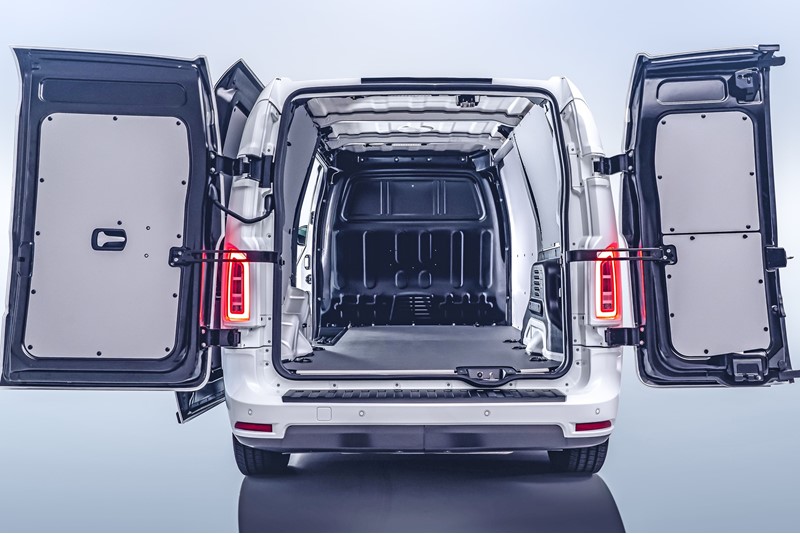
Benefiting from slim rear wheel boxes and having eight tie-down points, the cargo bed can accommodate two Euro pallets. The sliding door apertures are wide enough to allow one to be side-loaded, with the other fork-lifted through the rear.
The van sits on 17-inch wheels and is equipped with electro-hydraulic power steering delivering a 10.1m turning circle. The suspension features MacPherson struts and an anti-roll bar at the front along with a five-link set-up and a transverse composite leaf spring at the rear.
VN5 is covered by a five-year/150,000-mile warranty increasing to eight years/150,000 miles for the battery, and the service interval is set at
12 months/25,000 miles.
LEVC is embarking on a fleet trial programme with operators such as the Royal Mail and DPD among the 25-plus businesses involved, and is steadily developing a network of sales and service outlets. More than 50 locations should be in place by the end of the year.
The fleet trial vehicles are in fact TXs with the rear passenger area converted into a cargo bay. “We decided to adopt that approach to give operators some experience of the technology in advance of the van’s launch,” he says.
Equipped with LED headlights, the van is based on an all-aluminium monocoque that is bonded together, with no welding or riveting, and clad with SMC (sheet-moulding compound) panels made from a glass-fibre reinforced polyester material which are bonded into place.
The entire structure is light and strong, and will not corrode. The body is 30% lighter than a conventional steel body says LEVC, which claims that pound-for-pound it can soak up twice the crash energy mild steel can be absorb.
SMC is by no means unknown in the commercial industry and has a long pedigree. ERFs were fitted with cabs using SMC panels fixed to a steel frame.
VN5’s rot-proof structure and the technology it uses – electric motors require next to no servicing – ought to prompt fleets and leasing companies to revise their views on how long newly-acquired light commercials should remain in service, says Drake-Lee.
“Our vehicle makes a shift to a longer first-life possible, from a typical three years to six or seven,” he contends. “Some of the contract hire companies are very receptive to this idea and recognise that we’re seeing a paradigm shift in the market.”
Lex Autolease has arrived at a half-way house, quoting a monthly rate of £493.92 plus VAT based on a 60-month/20,000-miles-a-year contract excluding maintenance.
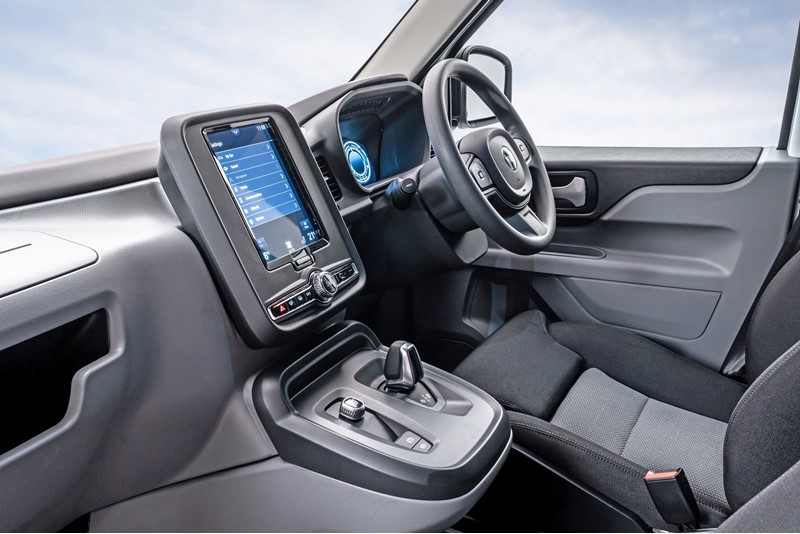
Three VN5 spec levels are listed – Business, City and Ultima – with all models equipped with autonomous emergency braking system (AEBS), driver and passenger front and side airbags, cruise control, a nine-inch touchscreen and dual-zone climate control. City additionally features extras such as front and rear parking sensors and lane departure warning, while Ultima includes a rear-view camera and the aforementioned 22kW AC onboard charger.
Option packs listed include Comfort (with sat-nav and a heated windscreen among other items) and Safety (including road sign information system and speed limit intelligent function).
Prices will start at £46,500 excluding VAT and excluding the Government’s plug-in van grant. “It should qualify for the full £8,000,” says Drake-Lee.
That still makes it pricier than a diesel.
“Remember though, that you are looking at a fuel cost of around 2p a mile compared with 11p a mile for an equivalent diesel model,” he adds.
Like the cab, the van is built at LEVC’s Ansty, Coventry plant. It can produce 20,000 vehicles a year, says the company.
Geely has pumped more than £500 million into LEVC since 2014 and the all-new factory began assembling vehicles in January 2018. Since then, it has built in excess of 4,000 cabs.
That means it has been running at significantly below capacity, but LEVC aims to have it operating at maximum output come 2022. The van is expected to account for 70% of its total volume.
LEVC has also developed the TX Shuttle. Using exactly the same technology as TX and VN5, it is aimed at public transport operators wanting to offer demand-responsive ring-and-ride services.
A short test drive along dual carriageways and around roundabouts close to the Ansty factory showed that TX Shuttle offers strong acceleration, rides and handles well, is well put together and is, of course, remarkably quiet. VN5 looks set to share these characteristics.
LEVC plans to expand the VN5 range and is making the model available to converters. Modul-System has already kitted one out with racking so it can be used as a mobile workshop.
“We have no plans to produce it as a chassis cab however,” Drake-Lee says. “At least not in the short term.”



